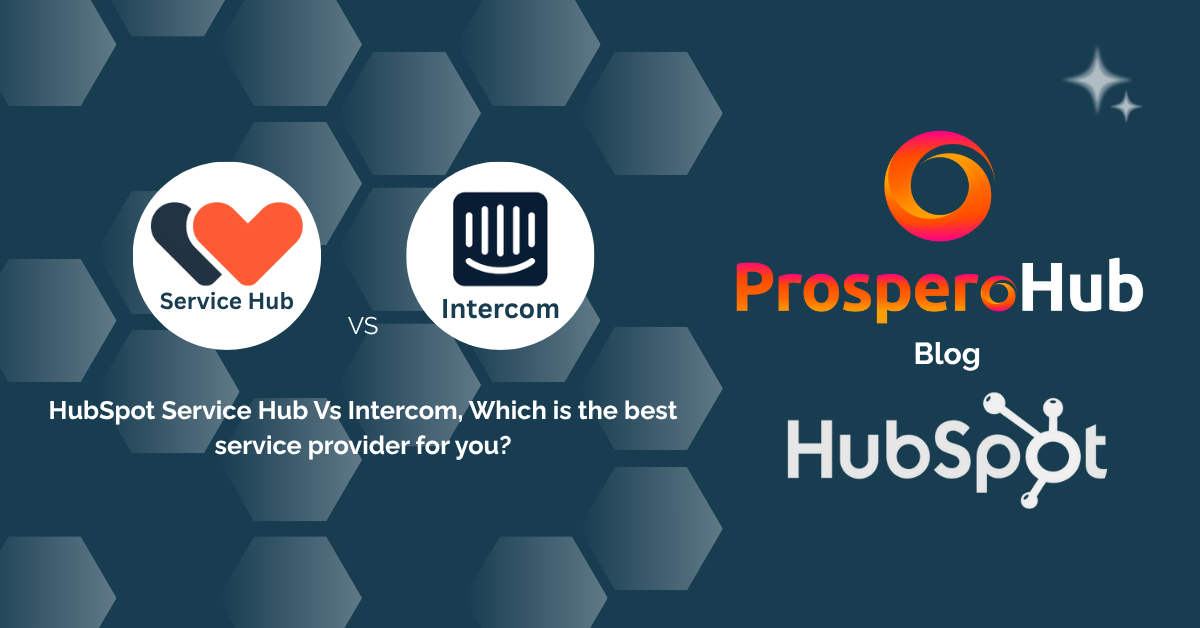When it comes to customer service software, HubSpot Service Hub and Intercom are two of the most recognisable names in the industry. Both promise to help you manage customer inquiries, streamline communication, and keep your clients happy.
But while Intercom is widely known for its chat-first approach, HubSpot Service Hub delivers a broader, more integrated customer service solution. Making it the better choice for most businesses looking for long-term scalability and ROI.
In this comparison, we’ll explore the strengths and weaknesses of each platform, why HubSpot Service Hub ultimately wins and why you should choose ProsperoHub to support the switch.
Short on time? Click here for a comparison at a glance.
HubSpot's Service Hub
Our customers choose HubSpot Service Hub beacuse it delivers a more human and relationship-driven approach to customer service. It is built directly into the HubSpot CRM so your team can track customer health scores, engagement levels, and lifecycle stages in real time. This allows the customer success team to see instantly which customers are thriving, which are at risk, and which need proactive outreach. With all customer information being in one integrated system, the AI agent has access to richer, real-time information, enabling it to deliver more accurate and relevant responses to customers.
As a result, they can prioritise effectively and deliver personalised support. Customers can be placed into tailored workflows based on their needs or status, ensuring they receive timely follow-ups, educational resources, or targeted offers that strengthen their relationship with your business. For example, if a high-value customer logs multiple support tickets in a short period, HubSpot can automatically flag them as “at risk,” route them to a senior agent, and enrol them in a personalised workflow that includes a follow-up call, a satisfaction survey, and an exclusive offer. This helps save you time and makes sure nothing slips through the cracks.
Other features like customer scoring ensures that the most valuable accounts receive the attention they deserve without neglecting other clients. With skill-based routing, layered SLAs, and automation, HubSpot enables faster response times, which in turn increases customer satisfaction and loyalty.
The outcome is a service experience where customers feel seen, valued, and understood, which strengthens relationships and supports long-term business growth.
What Service Hub And Intercom Both Offer
While HubSpot's Service Hub and Intercom take different approaches to customer service, there are several core features where both platforms deliver solid, dependable functionality. Ticket management is one such area, both systems offer tools to log, assign, and track customer issues efficiently. Agents can categorise tickets, set priorities, and use automation rules to streamline workflows and reduce response times. Whether you're using HubSpot's intuitive pipelines or Intercom's conversation-based ticketing, both platforms support efficient case resolution at scale.
Another feature where both platforms are evenly matched is the knowledge base and customer self-service functionality. Both HubSpot and Intercom allow you to build well-organised help centres that empower customers to find answers on their own, reducing the load on your support team. Articles can be categorised, searchable, and optimised for SEO, with permissions and versioning available in both systems. While HubSpot includes a dedicated customer portal and Intercom provides a streamlined help centre experience, each platform enables users to track their own support history and submit new requests — providing transparency and a better customer experience overall.
Stand Out Service Hub Features
One of the biggest concerns businesses have when switching platforms is the complexity of migrating data and getting their team up to speed. Fortunately, moving from Intercom to HubSpot Service Hub is a particularly smooth transition. This is because HubSpot’s CRM-first foundation is designed to be flexible, scalable, and highly customisable so perfect for your buisness.
1. CRM Integration & Unified Customer Data
HubSpot Service Hub is built natively into the HubSpot CRM, meaning every interaction — from sales to marketing to service — is stored in one centralised record. You can track the entire customer journey without switching tools or manually importing data.
Intercom, while powerful for messaging, is a standalone system. Integrations with CRMs are possible, but they require additional setup and sometimes third-party connectors.
Why it matters: A unified CRM ensures every team member has the same customer context, leading to faster resolutions and more personalised service.

2. Ticketing, Self-Service & Multi-Channel Support
HubSpot Service Hub offers a full-featured ticketing system with configurable pipelines and enforceable SLAs to drive accountability and rapid resolution. It includes a robust knowledge base for customer self-service, empowering users to find answers independently while easing the load on your support team. Clients also benefit from a dedicated customer portal, allowing them to track progress and manage their requests with full transparency.
All communications are streamlined through a unified inbox that consolidates email, live chat, and online forms — and with automatic, multi-channel ticket creation, tickets are generated instantly from any of these sources, plus connected phone systems and integrations, ensuring no request is ever missed.
Intercom focuses heavily on live chat and bots. While it has a help centre feature, it lacks a true built-in customer portal and relies on chat-first workflows, which can limit flexibility for teams handling email-heavy or multi-channel support.
Why it matters: A multi-channel, self-service-friendly approach is essential for scaling customer service beyond one-to-one live chats.
3. Automation, Reporting & Analytics
HubSpot Service Hub provides customisable workflows that automate ticket routing, follow-ups, and surveys, enabling teams to streamline processes and enhance efficiency.
The automation extends to layered SLA management, allowing you to set different SLA rules for different ticket types or customer segments — for example, giving VIP customers faster response times. Skill-based ticket routing further ensures inquiries are sent to the most qualified agent based on expertise, customer type, or workload.
Its in-depth reporting dashboards offer comprehensive visibility into SLAs, agent performance, and customer satisfaction, ensuring service standards are consistently met and opportunities for improvement are easily identified. Additionally, the platform features full integration with marketing and sales analytics, allowing businesses to connect service insights with broader commercial objectives and drive continuous improvement across all customer-facing functions.
Intercom excels in proactive messaging and bot-based automation, but its reporting is more limited and sometimes requires additional tools or paid add-ons to match HubSpot’s depth.
Why it matters: For businesses wanting to continuously optimise service operations, HubSpot’s native analytics give you the insights you need — no extra spend required.

4. Ease of Use, Learning Curve & Coaching
HubSpot’s interface is known for being clean, intuitive, and beginner-friendly. Setting up custom properties, workflows, and reporting does take some time, but the learning curve is extremely manageable across teams.
Adding to this, HubSpot includes in-built coaching tools, allowing managers to review conversations, leave comments, and track agent progress without leaving the platform — helping maintain consistent quality and ongoing staff development.
Intercom has a sleek chat interface, but its more advanced features — especially for campaign building and automation — can be more complex to master, and it lacks native coaching features.
Why it matters: The easier the system is to use and coach within, the faster your team can deliver great service.
5. Pricing & Value for Money
HubSpot offers a free plan with core tools, plus flexible paid tiers that scale as you grow. If you already use HubSpot Marketing or Sales Hubs, the added value is significant.
Intercom offers a free trial but no permanent free tier, and pricing can climb quickly with add-ons like advanced bots, analytics, and integrations.
Why it matters: Over time, HubSpot often delivers better ROI thanks to its all-in-one nature and ecosystem benefits.
Compared Features at a Glance
| Feature | HubSpot Service Hub | Intercom |
| CRM Integration | Fully native in HubSpot CRM — all sales, marketing, and service data in one record. | equires integration with external CRM, often via third-party connectors. |
| Customer Portal | Yes - branded, fully integrated with tickets and knowledge base for transparency. | No dedicated customer portal; relies on chat and help center articles. |
| Reporting & Analytics | In-depth, native dashboards with cross-department metrics and SLA tracking. | Limited without paid add-ons; focused on conversational metrics.ns |
| Ticketing System | Robust and fully customisable with pipelines, properties, and automation. | Ticketing tied primarily to conversations; less flexible for multi-channel workflows. |
| Knowledge Base | Yes — fully integrated with ticketing and CRM; supports proactive suggestions. | Yes — streamlined, but less connected to CRM and broader workflows. |
| Multi-Channel Support | Unified inbox for email, live chat, forms, and phone; tickets created automatically from all channels. | Primarily chat-focused; email and other channels require extra setup. |
| Automation Workflows | Advanced, highly customisable across sales, marketing, and service | Automation mainly for chat and bot flows; less CRM-linked flexibility. |
| In Built Coaching | Native conversation review and coaching tools for managers. | No built-in coaching features; requires third-party solutions. |
| Integration with Sales & Marketing | Deep, native integration enables shared data and workflows across all teams within one platform. | Integrates via APIs but requires setup; not natively unified. |
| SLA Management | Layered SLAs for different customer tiers; automated escalation and tracking. | Basic SLA options; lacks multi-tier automation. |
| Pricing Transparency | Free plan + scalable paid tiers; strong value if using other HubSpot hubs. | No permanent free plan; costs can rise quickly with add-ons |
Why Choose ProsperoHub To Switch
At ProsperoHub, we’re no strangers to guiding companies through successful HubSpot implementations and platform migrations and that includes moving from Intercom to HubSpot Service Hub. In fact, we've supported numerous businesses in making the switch, helping them unlock a more unified, efficient, and scalable approach to customer service.
Our experienced team understands the nuances of both platforms, which means we can ensure a smooth transition with minimal disruption. From migrating your data and setting up custom workflows to training your team and optimising for long-term success, we're here to handle every step of the process.
If you're considering the move, we’d love to chat. Book A Meeting with one of our HubSpot specialists, we’ll walk you through what to expect, highlight the powerful features HubSpot has to offer, and help you decide if it’s the right fit for your business. With ProsperoHub, switching to HubSpot doesn’t just feel easy, it actually is.


.png?width=1940&height=1024&name=Part%20of%20Siloy%20logos%20(2).png)



.png?width=125&height=125&name=DataMigration534x534%20(1).png)
-1.png?width=125&height=125&name=Untitled%20design%20(4)-1.png)
